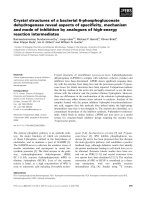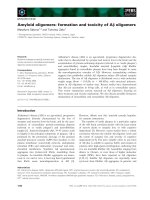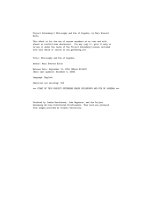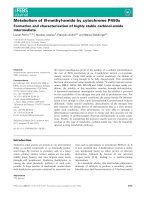Colonization, biofilm formation and biodegradation of polyethylene by soil bacteria
Bạn đang xem bản rút gọn của tài liệu. Xem và tải ngay bản đầy đủ của tài liệu tại đây (933.79 KB, 37 trang )
Colonization, biofilm formation and
biodegradation of polyethylene by
soil bacteria
Alex Sivan
The Institute for Applied Biosciences and
The Department of Biotechnology
Engineering, Ben Gurion University, Beer
Sheva, Israel
Environmental Engineering, 17.12.02
Polyethylene for soil mulching
In the U.S. ~ ca. 1,000,000 Ton/year in agriculture
Polyethylene waste
• 25,000,000 Ton/year
• Makes up to 40% of the plastic waste
• Highly flammable; burning releases toxic gases
• Pollutes marine and fresh water habitats
• Highly recalcitrant; > 400 years for degradation
Polyethylene rec
• Applications:
fences, side-walks, aco
• Cost of recycled products.
• Variable quantities in time a
• Currently, only ca. 15% of th
Alternative polyet
• Photodegradable polye
–Contains toxic metals.
–Requires long exposure t
• “Biodegradable” polye
–PE - starch copolymers.
–Only the starch is degrad
PE degradation
40
Soil
30
Loess A
Ein Tama
Loess B
Peat
20
Weight loss (%)
10
0
30
50
Temperature (C°)
Control
Bacteria
Methodology
• Polyethylene:
Linear LDPE
U.V. photosensi
• U.V. pretreatment: Accelerated w
5 U.V. cycles
1 hr water co
between cycles.
• Total irradiation: 60 hr of U.V.
• Disinfestation/sterilization
Biodegradation assay
• ca. 100 mg polyethylene in c
synthetic medium
• Inoculation
• Incubation at 30ºC or 50ºC
• Dry weight of polyethylene
Bacterial growth on PE
Bacterial C.F.U./ml
10
10
10
10
10
10
10
10
10
10
9
P33- PE
P33+PE
8
7
6
5
P34- PE
P34+PE
9
8
7
6
5
0
5
10
15
Time (days)
20
Effect of pH
Weight loss (%)
12
10
50 C
8
6
4
2
0
5
7.6
pH
8.5
Biofilm on polyethylene
Bacterial addhesion to hydr
100
Rhodococcus
rhodochrous
90
Log.
hex
Stat. hex
Log. octa
Stat. octa
80
% of initial O.D.
70
0.00 0.04 0.08 0.12 0.16 0.20
Hydrocarbon added (ml)
Hydrophobicity of PE - degrading bacteria
measured by contact angle
Medium pH
Bacterium
6
7
8
Bacillus 707
3.4
36.7±1.5
60.6±4.0
62.0 ±
Bacillus 712
±0.5
51.6±2.8
58.3±2.8
69.6
Rhodococcus
Effect of mineral oil on biof
on polyethylene
Rhodococcus
rhodochrous
by
5
4
Control
MO
(0.05
Tw 20 (0
3
Colonization index
2
1
00 5 10 15 20 25 30 35 40
Incubation time (days)
Development of bacte
16 hr
7 days
16 hr
16 hr
SM
SM + MO
Biofilm + Mineral oil
(16hr)
Biofilm + Mineral oil (7
days)
Mix C30
Effect of an anionic surfactant and mineral
oil on biofilm formation on polyethylene
Incubation time (days)
Additive
Conc.
(%;v/v)
4
10
17
30
Mineral oil
0.01
0.05
0.1
2*
3
3
3
4
4
3
4
4
3
4
4
Tween 60
0.1
0.5
1.0
0
0
0
0
0
0
0
0
0
0
0
1
0
0
1
1
Control
* Biofilm density index: 0 = No biofilm; 4 = Dense biofim
Increased weight loss (%)
Improved biodegradation of polyethylene
by mineral oil
50
40
30
20
10
0
0.02
0.05
0.1
Mineral oil concentration (%)
FDA hydrolysis by the bacterial biofilm
R2 = 0.983
0.2
3 pieces
0.1
O.D.494
1 piece
R2 = 0.982
0.0
0
100
200
Time (min)
300
Combined photolysis and biodegradation
• Polyethylene:
Linear LDPE MW 100,000
contains UV sensitizer
• UV pretreatment:
Accelerated Weathering
Tester (Q.U.V)
60 Hr of UV 312nm
Biodegradation of polyethylene by strain 707
20
Weight Loss (%)
* 50C
15
U.V. exposure
60
80
100
120
10
5
0
0
15
30
45
60
75
Incubation time (Days)
90
Hr
Hr
Hr
Hr









